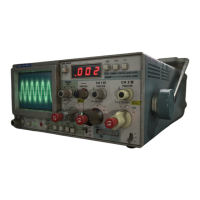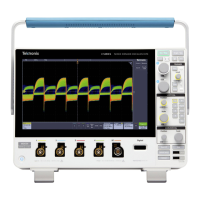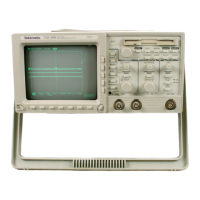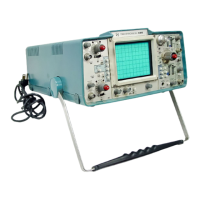Theory of Operation-314 Service
CHOP.
In the Chop mode, the Switching Multivibrator
f0.6 volt on Q105-(2110 emitters, to ensure the operation
stage free runs as an astable multivibrator at about 100
of the Diode Gate stage. (2105 and Q110 also provide the
kilohertz. The emitters of Q115 and
(2125 are connected to
current drive for the Current Limiter stage.
-6 volts through
R118, R128, through R140 and TI40
primary. At the time of turn on, one of the transistors
begins-to conduct; for example, Q115. The negative level
at Q115 collector forward biases CR106 and CR107 and
back biases CR105 and CR108, preventing the Channel 1
signal from reaching the Common-Base Amplifier.
Meanwhile, the Channel 2 Diode Gate passes the Channel
2 signal to the Common-Base Amplifier.
The frequency-determining components in the Chop
mode are
Cllg, Rllg, R118, and R128. Switching action
occurs as follows: when Q115 is on,
C119 attempts to
charge to -6 volts through R128. The emitter of Q125
goes slowly toward -6 volts as
C119 charges. The baseof
Q125 is held at a negative voltage determined by the
voltage divider R116-R127, between -6 volts and the
collector voltage of (2115. When the emitter voltage of
Q125 reaches a level slightly more negative than its base,
Q125 conducts. (212.5 collector level goes negative and
pulls the base of Q115 negative through divider R117-
R126 to turn Q115 off, switching the Diode Gate stage to
connect the opposite half to the Common-Base Amplifier
stage. Again,
C119 begins to charge toward -6 volts, this
time through R118. As C119 charges, the emitter of (2115
goes slowly negative until Q115 turns on. Q125 is off and
the cycle begins again.
The Chopped Blanking Amplifier stage, (2145, provides
an output pulse to the Unblanking circuit that blanks the
transitions between the Channel 1 and the Channel 2
traces. When the Switching Multivibrator stage changes
states, the voltage across
TI40 momentarily increases. A
negative pulse is applied to the base of (2145 to turn 0145
off. The width of the pulse at the base of Q145 is
determined by R142 and C142. Q145 is driven quickly into
cutoff, and the positive-going output pulse, which coin-
cides with traceswitching, isconnected to the Unblanking
circuit through R147.
ADD. In the Add mode, S130A and B closed, the Diode
Gate stage permits both signals to pass to the Common-
Base Amplifier stage. The Diode Gates are both held on by
-6 voltsapplied to theircathodes through
R108and R105-
R106. Since both signalsareapplied to the Common-Base
Amplifier stage, the output is the algebraic sum of the
signals on Channels 1 and 2.
The Common-Mode Adjustment, R108, sets the deflec-
tion plate levels of the Vertical Output Amplifier in the Add
mode.
Current Limiter
The Current Limiter stage (CR114, CR115, CR116, and
CR117, see Fig. 3-4) decouples the Delay-Line Driver
stage from the Common-Base Amplifier during overdrive
conditions, preventing the Output Amplifier from being
driven to a non-linear operating region.
Delay-Line Driver
Output of the Current Limiter stage is applied to the
Delay-Line Driver stage, (21.50 and Q160. Q150 and Q160
are connected as feedback amplifiers with R150-R156 and
R160-R166 providing feedback from the collector to the
base of their respective transistor. A
sampleof thesignal in
the collector circuit of Q160 is used for triggering in the
COMP TRIG mode. C153-C154 and R154 provide high-
frequency compensation of the delay line termination.
The output of the Delay-Line Driver stage is connected to
the Vertical Output amplifier through the Delay Line,
DL1 80.
VERTICAL OUTPUT
AMPLIFIER
@
General
The Vertical Output Amplifier circuit provides the final
amplification for the vertical deflection signal. This circuit
includes the delay line. Fig. 3-7 isadetailed block diagram
of the Vertical Output Amplifier circuit.
Delay Line
Delay Line DL180 provides approximately 270
nanoseconds delay to the vertical signal to give the Sweep
Generator circuit time to initiate a sweep before the
vertical signal reaches the vertical deflection plates of the
crt. This delay permits display of the leading edge of the
signal that initiates the trigger (when using internal
triggering).
Output Amplifier
Q188 and Q198 are connected as common-base
amplifiers to provide a low input impedance to properly
terminate the delay line. Q188 and Q198 also provide
isolation between the delay line and the following stages.
Q105 and Q110 are connected as common-base Q200, (2202, (2205, Q206, Q210, Q212, Q215, and (2216
amplifiers to provide a low impedance load, with about are connected as push-pull multi-stage operational
3-8
REV.
A,
AUG.
1975

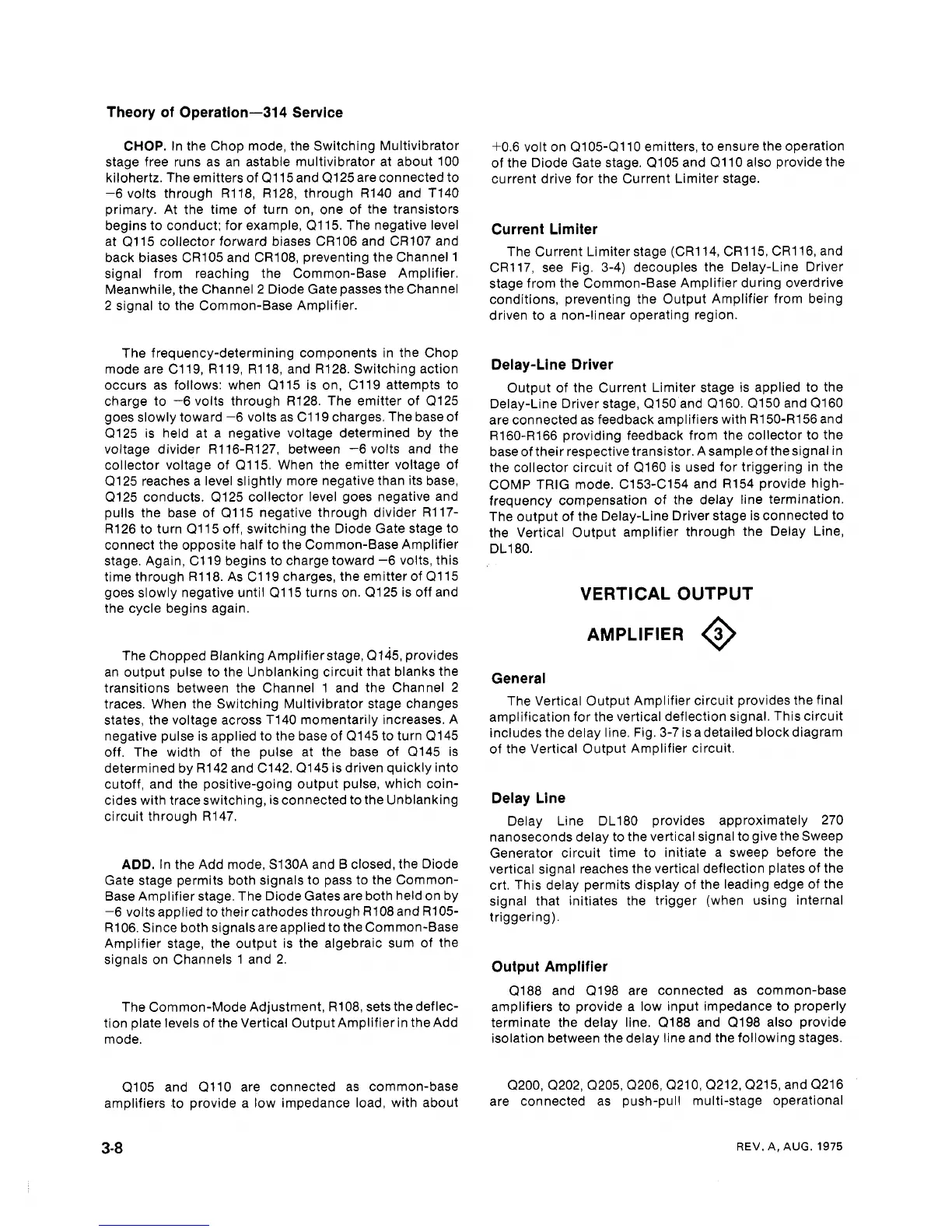